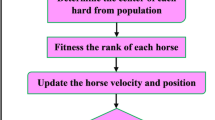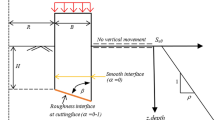Abstract
In this paper, Artificial Neural Networks (ANNs) are applied to the prediction of lateral behavior of single and group piles. The results of neural networks are compared with the measured data from the model tests. A series of model tests were performed with single and group piles in the Nak-Dong River Sand. For the verification of applicability of BPNN (Back Propagation Neural Network), the Modified BPNN and SNN (Sequential Neural Network), a total of 200 model test results for single and group piles were used. Also, in this study, the structure of neural network with one input layer-two hidden layerone output layer was used. The number of neuron for each hidden layer determined to be 30 from the results of model test and the learning rate determined to be 0.9 to optimize network learning. Compared with BPNN, the learning epoch of the modified BPNN for the same learning pattern is reduced to 88% at the maximum and the convergence to a global minimum is guaranteed. The investigation confirmed that a SNN with feedback is more effective than a conventional ANN without feedback to simulate the lateral behavior for single and group piles. It is concluded from this study that artificial neural ne tworks based on pile-soil interaction models can be developed by properly predicting and learning algorithms based on a comprehensive data set, and that useful inferences can be made from such models.
Similar content being viewed by others
References
W.T. Chan, Y.K. Chow and Liu, L.F. (1995). “Neural network: An alternative to pile driving formulas.”Comp. And Geotechnics, 17, 135–156.
Ellis, G.W., Yao, C., Zhao, R. and Penumadu, D. (1995). “Stress-strain modeling of sands using artificial neural networks.”J. Geotech. Engrg., ASCE, 121(5), 429–435
French, M.N., Krajewski, W.F., and Cuykendall, R.R. (1992). “Rainfall forecasting in space and time using a neural network.”J. Hydrol., Amsterdam, 137, 1–31.
Fukuoka, Y., Matsuki, H., Minamitani, H., and Ishida, A. (1998). “A modified back-propagation method to avoid false local minima.”Neural Networks, 11, 1059–1072.
Goh, A.T.C. (1996). “Neural networks modeling of CPT seismic liquefaction data.”J. Geotech. Engrg., ASCE, 122(1), 70–73.
Kiefa, M.A.A. (1998). “General regression neural networks for driven piles in cohesionless soils.”J. Geotech. Engrg., ASCE, 124(12), 1177–1185.
B.T. Kim (2000).Behavior of laterally loaded pile in Nonhomogeneous sand soil. PhD thesis, Kyung Pook National University, Daegu, Korea.
B.T. Kim and Y.S. Kim (2000). “Prediction of lateral deflection and maximum bending moment of model piles using artificial neural network.”J. of Korean Geotechnical Society, JKGS, 16(5), 169–178.
Kondner, R.L. (1963). “Hyperbolic stress-strain response: cohesive soils.”ASCE, 89(1), 115–143.
I.M. Lee and J.H. Lee (1996). “Prediction of pile bearing capacity using artificial neural networks.”Comp. And Geotechnics, 18(3), 189–200.
Mcclelland, J.L. and Rumelhart, D.E. (1998).Explorations in parallel distributed processing. The MIT Press, Boston, Mass.
Murchison, J.M. and ONeill M.W. (1984). “Evaluation of p-y relationships in cohesionless soils, in analysis and design of pile foundations.”ASCE, New York, 174–191.
Nawari, N.O. and Nusairat, J. (1999). “Artificial intelligence techniques for the design and analysis of deep foundations.”Electronic Journal of Geotech. Engrg., EJGE, Vol. 4.
Norris, G. (1986). “Theoretically based BEF laterally loaded pile analysis.”Numerical Methods in Offshore Piling 3rd international Conference, Navtes, 361–386.
Reese, L.C., Cox, W.R. and Koop, F.D. (1974). “Analysis of laterally loaded piles in sand.”Proc. 6th Offshore Technol. Conf., Dallas, Tex., 473–483.
Rumelhart, D.E., Hinton, G., and Williams, R. (1986). “Learning representations by back-propagating errors.”Nature, 323, 533–536.
Scott, R.F. (1980).Analysis of centrifuge pile tests: simulation of pile driving. Research Report, OSAPR Project 13, American Petro-leum Institute, 1980.
Teh, C.I., Wong, K.S., Goh, A.T.C., and Jaritngam, S. (1997). “Prediction of pile capacity using neural networks.”J. Comp. In Civ. Engrg., ASCE, 11(2), 129–138.
Zurada, J.M. (1992).Introduction to artificial neural system. West Publishing Co., St. Paul, Minn.
Author information
Authors and Affiliations
Corresponding author
Additional information
The manuscript for this paper was submitted for review on March 2, 2001.
Rights and permissions
About this article
Cite this article
Kim, B.T., Kim, Y.S. & Lee, S.H. Prediction of lateral behavior of single and group piles using artificial neural networks. KSCE J Civ Eng 5, 185–198 (2001). https://doi.org/10.1007/BF02829074
Issue Date:
DOI: https://doi.org/10.1007/BF02829074




